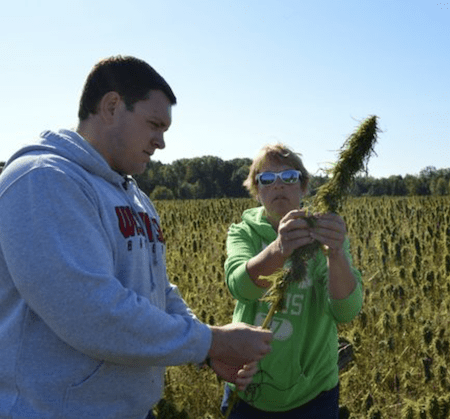WITTENBERG – Hemp farmers know it’s almost time to harvest when mourning doves show up to eat the seeds.
That’s one of many lessons Mike Omernik and Deb Tanis have learned this year growing the first hemp crop on their Wittenberg farm.
The couple is part of Wisconsin’s new research pilot program for industrial hemp that brought back a once-common crop after growth was banned for decades. Hemp is a cousin of the marijuana plant but contains very little THC, the active ingredient in pot that produces a high.
Omernik was looking for an alternative crop because corn wasn’t making the farm money, and he became interested in hemp. They applied for a license from the state in March and planted it in June. Now, it’s time to harvest their 35 to 37 acres of the plant.
“It’s a different experience,” Omernik said. “Sometimes you just got to give it a shot, see what we get.”

Wisconsin was once the second-largest producer of hemp in the United States, according to a 1918 report from the University of Wisconsin, growing 7,000 of the country’s 42,000 acres in 1917. The crop was grown primarily in Fond du Lac, Green Lake, Dodge and Racine counties.
But according to Purdue University’s Hemp Project, the Marihuana Tax Act of 1938 halted hemp production in the United States. And the Controlled Substance Act of 1970 classifies all forms of marijuana, including hemp, as a Schedule I drug.
The plant came back into the fold in 2014 when the federal government permitted states to allow growth under pilot programs with universities or state agricultural departments. The measure also distinguishes hemp from marijuana, defining it as a plant with less than 0.3 percent THC.
Last year, Gov. Scott Walker signed legislation paving the way for hemp’s return to Wisconsin. Under the state law, plants can’t contain more than 0.3 percent THC. The state won’t limit acreage or the number of licenses issued.
State Sen. Patrick Testin, R-Stevens Point, said farmers enrolled in the program must submit a research plan and pass a background check to ensure they don’t have a history of controlled substance use. They also need to provide the GPS coordinates of where the plants will be located.
The program received more than 250 applications for its first year, Testin said, a number he anticipates will grow going forward due to high interest in hemp.
“I think this is going to be transformational for the ag industry in this state, and I think within a few years Wisconsin will once again be a national leader in industrial hemp,” he said.
Growing hemp has been a learning process for Omernik and Tanis, and their biggest challenge was an absence of information. They couldn’t seek advice from other farmers in the state because names are kept private. Still, it’s a fun experience, Tanis said.
The couple hopes to yield between 800 and 1,000 pounds from the crop and, from there, make hemp oil and potentially biodiesel. Their plans have changed over the past few months as they’ve discovered more uses for hemp.
And Tanis emphasized that marijuana and hemp are nothing alike, despite being from the same family. People can smoke the whole field and it won’t impact them, she said.
“It’s like having a German Shepherd and a chihuahua,” she said. “They’re both canines, but they are totally different animals.”
Content from: https://www.wausaudailyherald.com/story/news/2018/09/24/hemp-wittenberg-farm-part-wisconsins-first-harvest-decades/1372605002/.